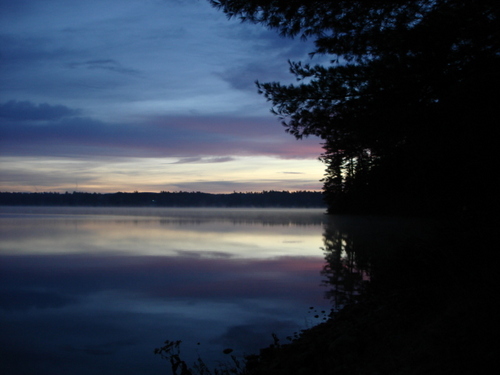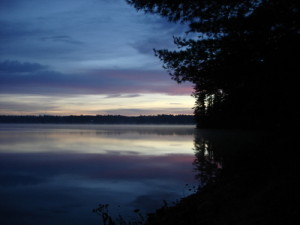Law Prevents Soil Erosion from Degrading Water Quality for Maine Lakefront Properties

Out and About for the Sebago Lakes Region of Maine April 25-May 1
April 24, 2013
Hikes In and Around Sebago Lake, Maine
April 28, 2013Law Prevents Soil Erosion from Degrading Water Quality for Maine Lakefront Properties

A Blue Hue on Square Pond in Shapleigh, Maine
Maine’s lakefront property owners benefit from the Erosion and Sedimentation Control Law, which came into effect in 1997. The law was designed to prevent further degradation of Maine waters by soil erosion and has been amended several times. It seems obvious, but we’ve noticed that not all landowners heed this law.
What is soil erosion? Erosion is the loss of soil from rain, snowmelt and wind. For example, every time it rains, water that doesn’t infiltrate into the ground often rushes off the property into nearby ditches or streams. This runoff can pick up different pollutants such as sand, silt, phosphorus, bacteria, oil and grease, litter, dog waste and more. Ultimately, these pollutants find their way into a nearby body of water.
Look at the muddy water flowing from rills and gullies and you’ll see the visible impact of eroded soils. What you won’t see is the damage to habitats used by fish and other aquatic life and declines in water quality.
For lakefront and all property owners, since ultimately, we all live in a watershed, this means that all construction projects requiring filling, displacing or exposing earthen materials, must use hale bales and silt fences to control sediment from being transported beyond the site or into a protected natural resource.
These measures must be in place on the downhill side of the construction or landscaping site before the activity begins and must remain so until the site is permanently stabilized. Permanent stabilization measures, e.g., erosion control mulch or vegetation, must be in place as soon as it is feasible during or immediately following completion of the project.
Landowners are required by this law to fix their erosion control problems. Examples of chronic erosion problems include the following:
• Camp roads that wash out every spring
• Culverts that are washing out around their inlets and outlets
• Ditches and embankments that are not stabilized with vegetation or riprap and show major rills and gullies
• Washouts in areas down gradient from any point of concentrated storm-water
runoff
The Full Text of the Law:
A person who conducts, or causes to be conducted, an activity that involves filling, displacing or exposing soil or other earthen materials shall take measures to prevent unreasonable erosion of soil or sediment beyond the project site or into a protected natural resource as defined in section 480-B. Erosion control measures must be in place before the activity begins. Measures must remain in place and functional until the site is permanently stabilized. Adequate and timely temporary and permanent stabilization measures must be taken and the site must be maintained to prevent unreasonable erosion and sedimentation.
A person who owns property that is subject to erosion because of a human activity before July 1, 1997 involving filling, displacing or exposing soil or other earthen materials shall take measures in accordance with the dates established under this paragraph to prevent unreasonable erosion of soil or sediment into a protected natural resource as defined in section 480-B, subsection 8.
Adequate and timely temporary and permanent stabilization measures must be taken and maintained on that site to prevent unreasonable erosion and sedimentation. This paragraph applies on and after July 1, 2005 to property that is located in the watershed of a body of water most at risk as identified in the department’s storm water rules adopted pursuant to section 420-D and that is subject to erosion of soil or sediment into a protected natural resource, as defined in section 480-B, subsection 8. This paragraph applies on and after July 1, 2010 to other property that is subject to erosion of soil or sediment into a protected natural resource as defined in section 480-B, subsection 8.
This section applies to a project or any portion of a project located within an organized area of this State. This section does not apply to agricultural fields. Forest management activities, including associated road construction or maintenance, conducted in accordance with applicable standards of the Maine Land Use Regulation Commission, are deemed to comply with this section. This section may not be construed to limit a municipality’s authority under home rule to adopt ordinances containing stricter standards than those contained in this section.
For more information about Best Management Practices to prevent soil erosion, visit the Maine DEP Web site.
To learn more about lakefront properties for sale on Square Pond in Shapleigh, Maine, which has above average water quality, click on the green box above.
To learn more about Square Pond and the Shapleigh area, check out the blog links below.
Square Pond in Shapleigh, Maine Provides Perfect Setting for Lakeside Relaxation
Great Fishing on Mousam and other Lakes in Shapleigh, Maine
Granny Kent Pond, Silver Lake (Poverty Pond), Little Poverty Pond and Pine Springs Lake: Four Small Lakes in Shapleigh, Maine

